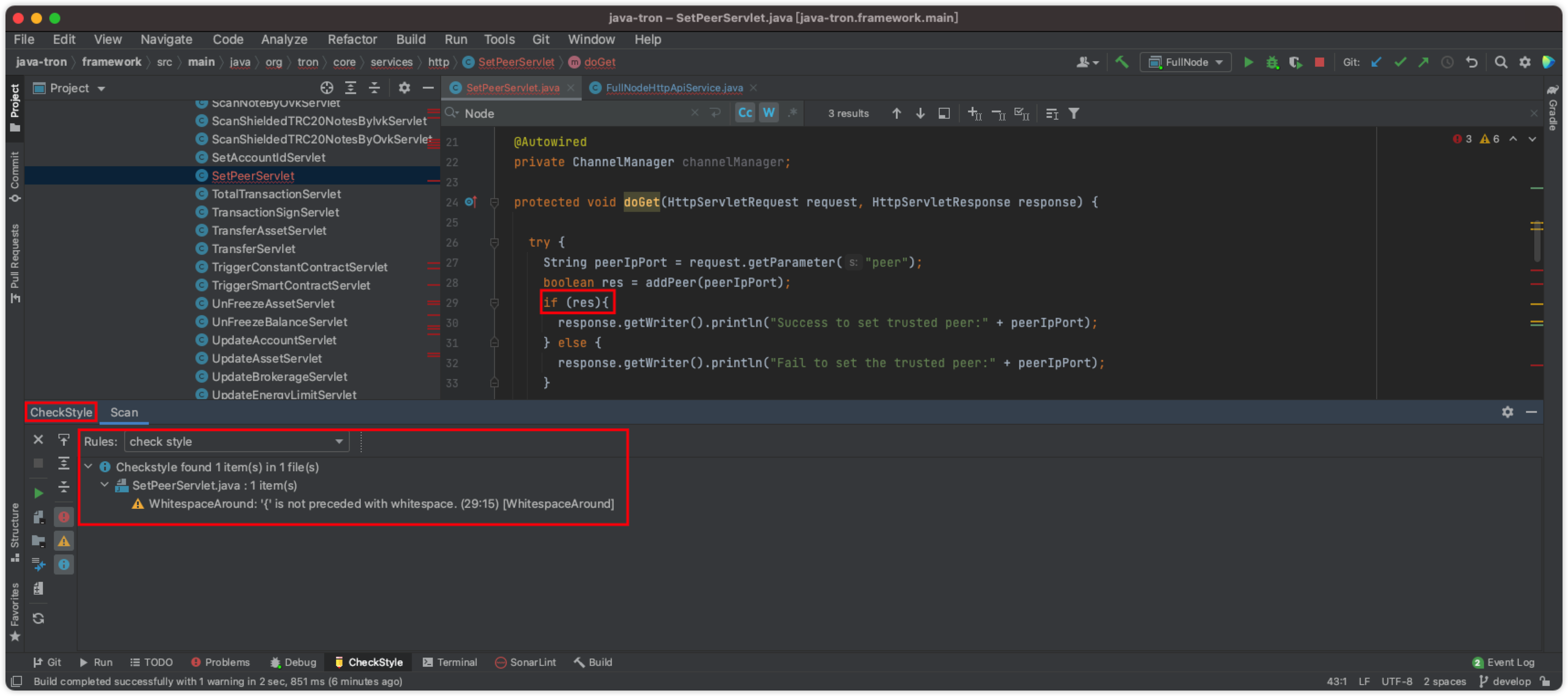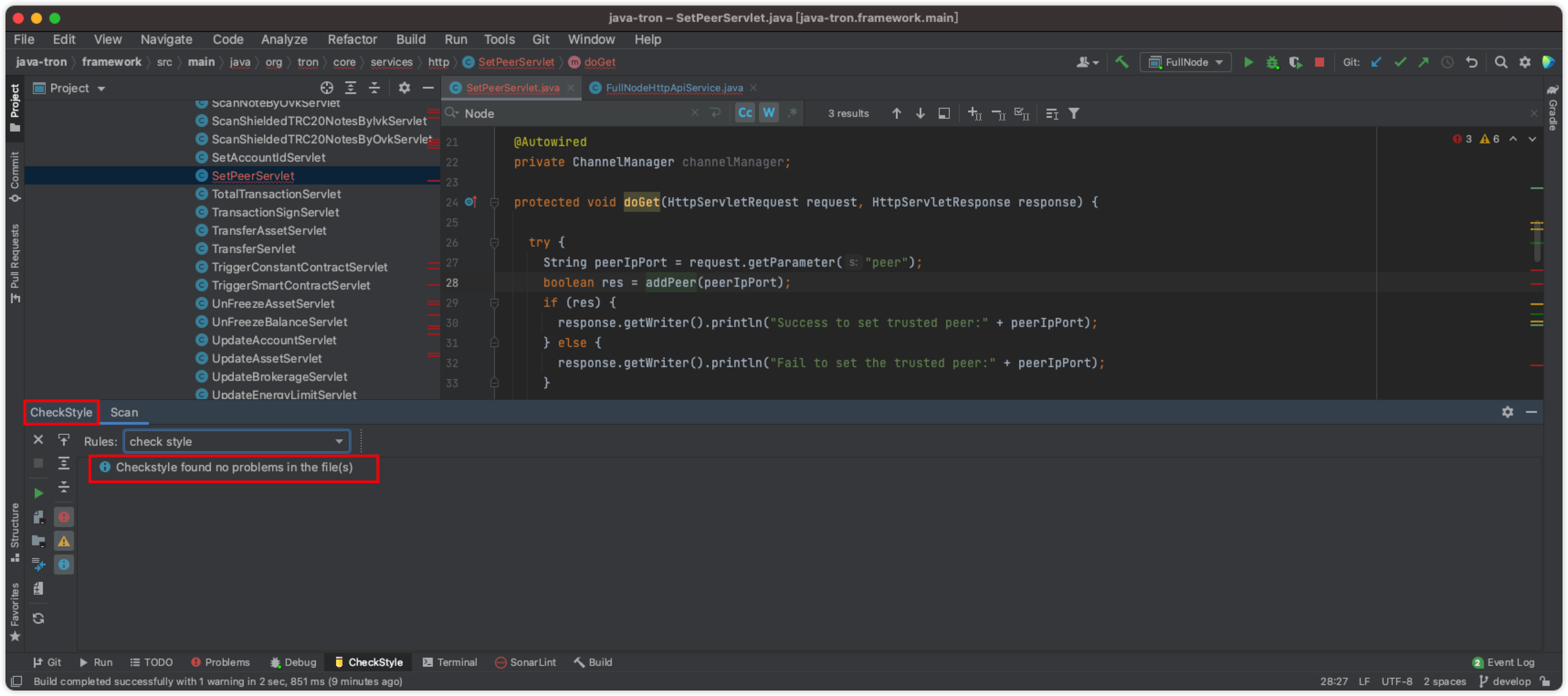Development Example¶
This document will detail the process of contributing to java-tron development, using the addition of a new setPeer HTTP API as a practical example. Before you begin, please ensure you have configured your development environment, for instance, by following the IntelliJ IDEA Development Environment Setup Guide.
Background: At times, a java-tron node may fail to connect to peers due to network issues. To enhance the stability of the node's network connections, we want to implement a feature that enables you to dynamically add trusted nodes while the node is running, ensuring connectivity even if the node discovery service fails.
1. Prepare the Development Environment¶
1.1 Fork the java-tron Repository¶
First, fork the official TRON GitHub repository, tronprotocol/java-tron, to your personal GitHub account. Then, clone your forked repository to your local machine and add the upstream remote to track official updates:
git clone https://github.com/yourname/java-tron.git
git remote add upstream https://github.com/tronprotocol/java-tron.git
1.2 Synchronize the Repository¶
Before starting development on a new feature, it is crucial to synchronize your personal fork with the upstream repository to get the latest code updates:
git fetch upstream
git checkout develop
git merge upstream/develop --no-ff
1.3 Create a New Branch¶
Create a new branch from your local develop branch for your development work. Please follow the branch naming conventions for naming your branch. For this example, we will use feature/add-new-http-demo as the branch name.
git checkout -b feature/add-new-http-demo develop
2. Code Implementation: Add the setPeer HTTP API¶
Open the java-tron project in IntelliJ IDEA. Next, we will implement a setPeer HTTP API to allow users to add trusted nodes via a POST request.
2.1 Create SetPeerServlet.java¶
In the java-tron/framework/src/main/java/org/tron/core/services/http directory, create a new Servlet class named SetPeerServlet.java. This class will contain doGet and doPost methods to handle HTTP GET and POST requests, respectively. If a specific request type is not supported, you can leave the corresponding method empty.
package org.tron.core.services.http;
import lombok.extern.slf4j.Slf4j;
import org.springframework.beans.factory.annotation.Autowired;
import org.springframework.stereotype.Component;
import org.tron.core.net.peer.ChannelManager;
import org.tron.core.net.peer.Node;
import org.tron.core.config.CommonParameter;
import org.tron.core.Constant;
import org.tron.core.exception.BadItemException;
import org.tron.core.services.http.fullnode.PostParams;
import org.tron.core.services.http.fullnode.Util;
import javax.servlet.http.HttpServlet;
import javax.servlet.http.HttpServletRequest;
import javax.servlet.http.HttpServletResponse;
import java.io.IOException;
import java.net.InetAddress;
import java.net.InetSocketAddress;
import com.alibaba.fastjson.JSONObject;
@Component
@Slf4j(topic = "API")
public class SetPeerServlet extends HttpServlet {
@Autowired
private ChannelManager channelManager;
protected void doGet(HttpServletRequest request, HttpServletResponse response) {
// GETrequests are not handled in this example
}
protected void doPost(HttpServletRequest request, HttpServletResponse response) {
try {
PostParams params = PostParams.getPostParams(request);
JSONObject jsonObject = JSONObject.parseObject(params.getParams());
String peerIpPort = String.valueOf(jsonObject.get("peer"));
boolean res = addPeer(peerIpPort);
if (res) {
response.getWriter().println("Success to set trusted peer:" + peerIpPort);
} else {
response.getWriter().println("Fail to set the trusted peer:" + peerIpPort);
}
} catch (Exception e) {
logger.error("Exception occurs when setting peer: {}", e.getMessage());
try {
response.getWriter().println(Util.printErrorMsg(e));
} catch (IOException ioe) {
logger.error("IOException occurs when setting peer: {}", ioe.getMessage());
}
}
}
private boolean addPeer(String peerIP) {
try {
if (peerIP != null && !peerIP.isEmpty()) {
Node node = Node.instanceOf(peerIP);
if (!(CommonParameter.PARAMETER.nodeDiscoveryBindIp.equals(node.getHost())
|| CommonParameter.PARAMETER.nodeExternalIp.equals(node.getHost())
|| Constant.LOCAL_HOST.equals(node.getHost()))
|| CommonParameter.PARAMETER.nodeListenPort != node.getPort()) {
InetAddress address = new InetSocketAddress(node.getHost(), node.getPort()).getAddress();
channelManager.getTrustNodes().put(address, node);
return true;
}
}
} catch (Exception e) {
logger.error("addPeer error - {}", e.getMessage());
}
return false;
}
}
In the code above:
- The
doPostmethod handles incoming POST requests. It extracts thepeerinformation (an IP address and port inIP:Portformat) from the request parameters. - The
addPeermethod adds the peer to the list of trusted nodes. The logic of this function is as follows:- Check the user-provided parameters to ensure the node's IP and port are not empty.
- Construct the node information using
Node.instanceOf(peerIP). - Ensure that the trusted node being added is not the current node itself.
- Add the node to the
ChannelManager's trusted nodes list.
2.2 Register SetPeerServlet with the HTTP API Service¶
After implementing SetPeerServlet, you need to register it with the node's HTTP API service. The FullNodeHttpApiService class serves as the entry point for registering all HTTP interfaces. In its start method, use context.addServlet to register SetPeerServlet as an HTTP API at the endpoint /wallet/setpeer:
package org.tron.core.services.http;
import org.springframework.beans.factory.annotation.Autowired;
import org.springframework.stereotype.Component;
import org.eclipse.jetty.servlet.ServletContextHandler;
import org.eclipse.jetty.servlet.ServletHolder;
import org.tron.core.services.Service;
@Component
public class FullNodeHttpApiService implements Service {
@Autowired
private SetPeerServlet setPeerServlet;
// ... other member variables and methods ...
@Override
public void start() {
// ... other initialization code ...
ServletContextHandler context = new ServletContextHandler(ServletContextHandler.SESSIONS);
// ... other Servlet registrations ...
context.addServlet(new ServletHolder(setPeerServlet), "/wallet/setpeer");
// ... other startup code...
}
// ... other methods ...
}
2.3 Debuging and Testing¶
Once the code changes are complete, you can start the java-tron node in IntelliJ IDEA for debugging. Then, use the curl command in your terminal to access the newly added HTTP API:
curl --location --request POST 'http://127.0.0.1:16667/wallet/setpeer' \
--header 'Content-Type: application/json' \
--data-raw '{
"peer":"192.163.3.2:16667"
}'
If the request is successful, you will receive the following response:
Success to set trusted peer:192.163.3.2:16667
setPeer feature is complete. Next, you need to write unit tests for these changes.
3. Writing Unit Tests¶
The java-tron project uses the JUnit framework for unit testing. For detailed information on using JUnit, please refer to the official JUnit documentation. Below is an introduction to the specifications and common annotations for java-tron unit test cases.
3.1 java-tron Unit Test Case Guidelines¶
When writing unit tests for java-tron, please adhere to the following guidelines:
- Directory and Package Structure: All test classes should be located in the
testdirectory and maintain the same package structure as the class being tested. We recommend suffixing test class names withTest. - Test Method Definition: Test methods must be annotated with
@Testand declared aspublic void. We recommend prefixing method names withtestto improve readability. - Method Independence: Each method in a test class should be runnable independently. There should be no dependencies between methods, ensuring the stability and maintainability of the tests.
3.2 Common JUnit Annotations¶
The following are commonly used annotations in JUnit. For more details, please consult the official JUnit documentation.
@Test: Marks a method as a test method that will be executed by the test runner.@Ignore: Ignores the current test method, preventing it from being executed (useful for temporarily skipping unstable or unfinished tests).@BeforeClass: Runs once before any of the test methods in the class. Must be astaticmethod (typically used for initializing shared resources).@AfterClass: Runs once after all test methods in the class have been executed. Must be astaticmethod (typically used for releasing shared resources).@Before: Runs before each test method (used to prepare the test environment, such as initializing data).@After: Runs after each test method (used to clean up the test environment, such as closing connections).
3.3 Composition of a Unit Test Class¶
A typical unit test class consists of the following three parts:
- Initialization Method: A method annotated with
@Beforeor@BeforeClassthat performs setup operations before tests are executed, such as preparing test data or configuring the environment. - Cleanup Method: A method annotated with
@Afteror@AfterClassthat performs cleanup operations after tests are executed, such as releasing resources or restoring data. - Test Method: A method annotated with
@Testthat contains the specific test logic to verify that the code behaves as expected.
import org.junit.After;
import org.junit.Before;
import org.junit.Test;
public class DemoTest {
@Before
public void init() {
// Initialization work before the test case runs
}
@After
public void destroy() {
// Data cleanup work after the test case runs
}
@Test
public void testDemoMethod() {
// Test logic
}
}
For this example, we should create a new test class file, SetPeerServletTest.java, in the framework/src/test/java/org/tron/core/services/http/ directory to write the corresponding test cases.
package org.tron.core.services.http;
import org.junit.After;
import org.junit.Assert;
import org.junit.Before;
import org.junit.Test;
import org.tron.core.config.args.Args;
import org.tron.core.net.peer.ChannelManager;
import org.tron.core.services.http.fullnode.SetPeerServlet;
import org.tron.core.db.Manager;
import org.tron.core.db.TronApplicationContext;
import org.tron.core.Constant;
import org.tron.core.services.Application;
import org.tron.core.services.ApplicationFactory;
public class SetPeerServletTest {
private static TronApplicationContext context;
private static Application appT;
public static ChannelManager channelManager;
@Before
public void init() {
Args.setParam(new String[]{}, Constant.TEST_CONF);
context = new TronApplicationContext(Manager.class);
channelManager = context.getBean(ChannelManager.class);
appT = ApplicationFactory.create(context);
appT.initServices(Args.getInstance());
appT.startServices();
appT.startup();
}
@After
public void destroy() {
Args.clearParam();
appT.shutdownServices();
appT.shutdown();
}
@Test
public void testAddPeer() {
SetPeerServlet setPeerServlet = new SetPeerServlet();
// Assuming 127.0.0.1 is the local IP, addPeer should return false
// because it should not add itself as a trusted peer.
Assert.assertFalse(setPeerServlet.addPeer("127.0.0.1"));
}
}
4. CheckStyle Code Style Check¶
Before submitting your code, be sure to run a CheckStyle code style check on the files you have modified. In IntelliJ IDEA, you can right-click a file and select "Check Current File". Fix any code style issues based on the prompts until all warnings are resolved.

After fixing the code style issues, run the check again to ensure all warnings have been resolved:

5. Submitting Code and Creating a Pull Request¶
5.1 Submit a Commit¶
After you have finished writing and testing your code, commit your changes. Please refer to the Commit Specification.
git add .
git commit -m 'feat: add new http api setpeer'
5.2 Push the New Branch¶
Push your new branch to your personal remote repository:
git push origin feature/add-new-http-demo
5.3 Submit a Pull Request¶
On GitHub, create a Pull Request from your repository to tronprotocol/java-tron. This will propose your changes to the official repository.

Please ensure your Pull Request description is clear and includes details about the changes you have made and their purpose.